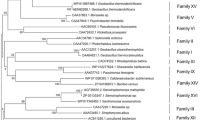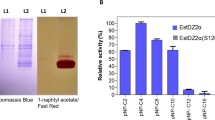Abstract
Two novel esterases (EstB1 and EstB2) were isolated from a genomic library of Bacillus sp. associated with the marine sponge Aplysina aerophoba. EstB1 shows low identity (26–44%) with the published hydrolases of the genus Bacillus, whereas EstB2 shows high identity (73–74%) with the carboxylesterases from B. cereus and B. anthracis. Both esterases were efficiently expressed in Escherichia coli under the control of T7 promoter using the vector pET-22b(+). Recombinant EstB1 was purified in a single step to electrophoretic homogeneity by IMAC. A method for the refolding of inclusion bodies formed by the recombinant EstB2 was established to obtain active enzyme. Substrate specificity of the two enzymes towards p-nitrophenyl and methyl esters and the respective kinetic parameters Km and Vmax were determined. The temperature optima of EstB1 and EstB2 were determined to be in the range of 30–50°C and 20–35°C, respectively. The pH optima were found to be in the range of 6.5–7.5 and 6.5–8.0, respectively. Both enzymes showed the highest stability in up to 50% (v/v) DMSO followed by methanol, ethanol and 2-propanol. The influence of high NaCl and KCl concentrations was tested. The inhibition effect of 10–50 mM Zn2+ and 50 mM Mg2+ and Ca2+ ions was observed for both esterases. One to five millimolar PMSF deactivated the enzymes, whereas β-mercaptoethanol, DTT and EDTA had no effect on the enzymes activity.






Similar content being viewed by others
References
Altschul SF, Gish W, Miller W, Myers EW, Lipman DJ (1990) Basic local alignment search tool. J Mol Biol 215:403–410
Bachkatova NA, Severina LO (1980) Isolation and characterisation of intracellular lipase from S. marcescens 345. Prikl Biokhim Mikrobiol 16(3):315–326
Barth S, Fischer M, Schmid RD, Pleiss J (2004) The database of epoxide hydrolases and haloalkane dehalogenases: one structure, many functions. Bioinformatics 20:2845–2847
Bornscheuer UT, Kazlauskas RJ (1999) Hydrolases in organic synthesis. Wiley-VCH, Weinheim
Bornscheuer UT (2002) Microbial carboxyl esterases: classification, properties and application in biocatalysis. FEMS Microbiol Rev 26:73–81
Brusca RC, Brusea GJ (1990) Phylum Porifera: the sponges. Sinauer AD (ed) Invertebrates. Sinauer, Sunderland, pp 181–210
Carrio MM, Cubarsi R, Villaverde A (2000) Fine architecture of bacterial inclusion bodies. FEBS Lett 471:7–11
Chung CT, Niemela SL, Miller RH (1989) One-step preparation of competent Escherichia coli: transformation and storage of bacterial cells in the same solution. Proc Natl Acad Sci USA 86:2172–2175
Cleij MC, Drenth W, Nolte RJM (1993) Enantioselective cleavage of ester by histidine-containing tripeptides in micellar solutions of various hexdecyltrialkylammonium bromide surfactants. Recl Trav Chim Pays-Bas 112:1–6
Edman P (1950) Method for the determination of the amino acid sequence in peptides. Acta Chem Scand 4:289–298
Eggert T, Pencreac’h G, Douchet I, Verger R, Jaeger K-E (2000) A novel extracellular esterase from Bacillus subtilis and its conversion to a monoacylglycerol hydrolase. Eur J Biochem 267:6459–6469
Fischer M, Pleiss J (2003) The Lipase Engineering Database: a navigation and analysis tool for protein families. Nucleic Acids Res 31:319–321
Gilbert JJ, Allen HL (1973) Chlorophyll and primary productivity of same green, freshwater sponges. Int Rev Ges Hydrobiol 58:633–658
Henke E, Bornscheuer UT (2002) Esterases from Bacillus subtilis and B. stearothermophilus share high sequence homology but differ substantially in their properties. Appl Microbiol Biotechnol 60:320–326
Hentschel U, Hopke J, Horn M, Friedrich AB, Wagner M, Hacker J, Moore BS (2002) Molecular evidence for a microbial community in sponges from different oceans. Appl Environ Microbiol 68:4431–4440
Hewson WD, Hager LP (1998) Bromoperoxidases and halogenated lipids in marine algae. J Phycol 16:340–345
Hofer P, Fringeli UP, Hopff WH (1984) Activation of acetylcholinesterase by monovalent (Na+, K+) and divalent (Ca2+, Mg2+) cations. Biochemistry 23(12):2730–2734
Laemmli UK (1970) Cleavage of structural proteins during the assembly of the head of bacteriophage T4. Nature 227:680–685
Lebaron P, Fajon C, Batailler N, Normand P (1995) Phenotopic and genetic diversity within a colony morphotype. FEMS Microbiol Lett 160:137–143
Luria SE, Adams JN, Ting RC (1960) Transduction of lactose utilizing ability among strains of E. coli and S. dysentria and the properties of the transducing phage particle. Virology 12:438–390
Mitraki A, King J (1998) Protein folding intermediates and inclusion body formation. Biotechnology 7:690–697
Molinari F, Brenna O, Valenti M, Aragozzini F (1996) Isolation of a novel carboxyesterase from Bacillus coagulans with high enantioselectivity toward racemic esters of 1,2-O-isopropylidenglycerol. Enzyme Microb Technol 19:551–556
Morrison M, Schonbaum GR (1976) Peroxidase-catalyzed halogenation. Ann Rev Biochem 45:861–88
Ollis DL, Cheah E, Cygler M, Dijkstra B, Frolow F, Franken S, Harel M, Remington SJ, Silman I (1992) The a/b hydrolase fold. Protein Eng 5:197–211
Peled N, Krenz MC (1981) A new assay of microbial lipases with emulsified trioleoyl glycerol. Ann Biochem 112:219–222
Quax WJ, Broekhuizen CP (1994) Development of a new Bacillus carboxyl esterase for use in the resolution of chiral drugs. Appl Microbiol Biotechnol 41:425–431
Rudolph R, Lilie H (1996) In vitro folding of inclusion body proteins. FASEB J 10(1):49–56
Sambrook J, Fritsch EF, Maniatis T (1989) Molecular cloning: a laboratory manual. Cold Spring Harbor Laboratory Press, Cold Spring Harbor
Sanger F, Nicklen S, Coulson AR (1997) DNA sequencing with chain-terminating inhibitors. Proc Natl Acad Sci USA 74:5463–5467
Schandl A, Pittner F (1984) The role of Na and Ca ions on the activation of pancreatic lipase studied with the help of immobilisation techniques. Eur J Biochem 140(3):547–551
Schmidt HA, Strimmer K, Vingron M, von Haeseler A (2002) TREE-PUZZLE: maximum likelihood phylogenetic analysis using quartets and parallel computing. Bioinformatics 18:502–504
Simons JW, van Kampen MD, Ubarretxena-Belandia I, Cox RC, Alves dos Santos CM, Egmond MR, Verheij HM (1999) Identification of a calcium binding site in Staphylococcus hyicus lipase: generation of calcium-independent variants. Biochemistry 38(1):2–10
Thompson JD, Gibson TJ, Plewniak F, Jeanmougin F, Higgins DG (1997) The CLUSTAL_X windows interface: flexible strategies for multiple sequence alignment aided by quality analysis tools. Nucleic Acids Res 25:4876–82
Traub PC, Schmidt-Dannert C, Schmitt J, Schmid RD (2001) Gene synthesis, expression in E. coli, and in vitro refolding of Pseudomonas sp. KWI 56 and Chromobacterium viscosum lipases and their chaperons. Appl Microbiol Biotechnol Mar 55(2):198–204
Tromp M, Van TT, Wever R (1991) Reactivation of vanadium bromoperoxidase; inhibition by metallofluoric compounds. Biochim Biophys Acta 1079(1):53–56
Vacelet J (1971) Etude en microscopie electronique de l’association entre une cyanophycee chroococcale et une eponge du genra Verongia. J Microsc 12:363–380
van Pee KH (2001) Microbial biosynthesis of halometabolites. Arch Microbiol 175:250–258
Wiesner W, van Pee KH, Lingens F (1988) Purification and characterisation of a novel bacterial non-heme chloroperoxidase from Pseudomonas pyrrocinia. Biol Chem 363(25):13725–137321
Wilkinson CR (1992) Symbiotic interactions between marine sponge and algae. In: Reisser W (ed) Algae and symbioses. Biopress, Bristol, pp 112–151
Acknowledgements
We thank Fatma Kabaoglu for providing the novel Bacillus strain used in that project. Part of this work (F.B.) was supported by the German Federal Ministry of Education and Research (BMBF) through the Screening Center project and the project Centre of Excellence BIOTECmarin (FO345D) and by the Ministry of Science, Research and Arts of the State of Baden-Württemberg and the University of Stuttgart.
Author information
Authors and Affiliations
Corresponding author
Electronic Supplementary Material
Rights and permissions
About this article
Cite this article
Karpushova, A., Brümmer, F., Barth, S. et al. Cloning, recombinant expression and biochemical characterisation of novel esterases from Bacillus sp. associated with the marine sponge Aplysina aerophoba. Appl Microbiol Biotechnol 67, 59–69 (2005). https://doi.org/10.1007/s00253-004-1780-6
Received:
Revised:
Accepted:
Published:
Issue Date:
DOI: https://doi.org/10.1007/s00253-004-1780-6




